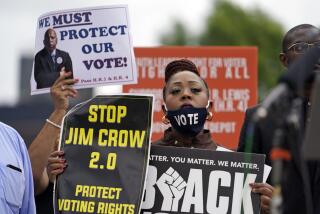Op-Ed: Dylann Roof and the white fear of a black takeover

Charleston police work outside the Emanuel African Methodist Episcopal Church, where a gunman killed nine people at a prayer meeting, in Charleston, S.C., on June 19.
- Share via
I noticed the flags first.
In the most widely circulated image of Dylann Roof, who is charged with murdering nine African Americans at Charleston, S.C.’s Emanuel African Methodist Episcopal Church, the white 21-year-old sports a jacket emblazoned with flag patches from two failed white supremacist states — Rhodesia and apartheid-era South Africa. In another shot, Roof appears to be showing off a flag-festooned license plate that pays homage to another failed white supremacist regime — the Confederate States of America.
When considered alongside the words the gunman allegedly uttered before opening fire — the last his nine victims heard on Earth — the flags point to a deep history of racial fear that Roof inherited and embodied Wednesday night.
According to eyewitness accounts, Roof said, among other things, “You’re taking over our country.” Most observers, a gaggle of dissembling politicians excepted, have taken the killer’s own words as evidence of racial motive, if not pathology.
For most of the South’s history, the fear of African Americans “taking over” has permeated mainstream political culture. That paranoia ran deepest in states like South Carolina, where African Americans constituted a majority of the population well into the 20 century. Whites in Charleston certainly acted on those fears in 1822, when they executed Denmark Vesey, a founding member of Emanuel AME Church, for plotting a slave rebellion. After emancipation, white supremacists stoked fears of “Negro domination” to overthrow South Carolina’s interracial Reconstruction government. The architects of Jim Crow enacted disfranchisement measures such as poll taxes and literacy tests as safeguards against the seemingly ever-present threat of another black takeover.
RELATED: Charleston church shooting victims: Who they were
It is fitting, if coincidental, that authorities apprehended Roof just across the state line in Shelby, N.C., the birthplace of the man who arguably did more than anyone to sear the specter of Negro domination into the national consciousness.
Thomas Dixon’s “The Clansman,” a novel set in Reconstruction-era South Carolina, inspired the 1915 blockbuster film “Birth of a Nation” and glorified white supremacist violence as a heroic response to black civic participation. Few remember Dixon’s apocalyptic final novel, “The Flaming Sword,” which depicted a Marxist-inspired, all-black “Nat Turner Legion” overrunning the South in the 1930s. Dixon died before he could complete his planned trilogy, in which a white “Patriot Union” would presumably take America back.
By the 1930s, South Carolina had lost its black majority to outmigration, but white supremacists continued to trade in fears of black domination. In 1936, Sen. “Cotton Ed” Smith stormed out of the Democratic National Convention in Philadelphia after a local black pastor rose to deliver the opening invocation. The mere hint of black inclusion in what Southerners regarded as the white man’s party sparked threats of a mass political defection.
In the early 1950s, South Carolina Democratic Gov. James F. Byrnes accused national party leaders of adopting a socialistic platform due solely to pressure from “Negro politicians … interested only in race problems.” South Carolina newspaperman William Workman, a prominent segregationist who defected to the Republican Party by the early 1960s, decried black activists’ growing political influence on both parties as proof of the “distressing tyranny of the numerical minority.”
The fear of blacks taking over worldwide also fueled American segregationists’ interest in southern Africa, where white-minority regimes in South Africa and Rhodesia teetered on the brink of collapse. Even as the international community shunned these pariah states, the segregationist Citizens’ Councils, which peaked at 40,000 members in South Carolina, claimed them as kindred spirits, while depicting African anti-colonialists and African American civil rights activists alike as spear-chucking savages and enemies of Western civilization.
Whatever he thinks he knows about southern Africa — he was born after white rule ended in both Rhodesia and South Africa — Roof is not the first white Southerner to feel connected to it.
Whether he knows it or not, Dylann Roof inherited a logic and a political legacy that defied statistics, the march of time, and any shred of common humanity. Generations of white supremacists stoked the fear that African Americans, whether a numerical majority or not, could take over a divided, apathetic, and unsuspecting white nation.
The obsession with black domination rendered African Americans simultaneously sub- and superhuman, unable to contribute to American society yet capable of destroying it. The domination myth proved just as contradictory for white supremacists, who simultaneously reveled in their superiority and lamented their political impotence at the hands of minority tyranny.
For those who persist in this phobia, the mere sight of black people engaging in American civic life — whether peaceful protestors and voters, a South Carolina state senator or the president of the United States — can be too much to take. Indeed, for decades, the central lesson of white supremacy was that any black engagement in public life could and would ultimately destroy the nation. As a native white Southerner, I had heard echoes of these fears straight from people’s mouths long before I encountered them in the archives.
Thank God, not everyone who still believes that African Americans are “taking over” is homicidal. Even if they are drawing their history from the same poisoned well as Dylann Roof.
Jason Morgan Ward is associate professor of history at Mississippi State University and author of “Defending White Democracy: The Making of a Segregationist Movement and the Remaking of Racial Politics, 1936-1965.” His second book, “Hanging Bridge: A Lynching Site and a Civil Rights Century,” will be published next year.
Follow the Opinion section on Twitter @latimesopinion and Facebook
More to Read
A cure for the common opinion
Get thought-provoking perspectives with our weekly newsletter.
You may occasionally receive promotional content from the Los Angeles Times.






